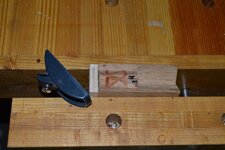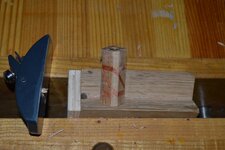So has anyone used a small hand planer to remove the edges on pen blanks or bottle stopper blanks?
Yes, I have. I have an inexpensive, but routinely and easily sharpened mini-block plan that is one of the most useful planes I own. It's a Buck Bros. that I bought at Home Depot many years ago.
I made a holder out of a scrap of "v-block" and screwed a stop on the end. I clamp it in my tail vice and knock down the corners of blanks that might have a risk of disaster on a catch, like this celtic knot blank. That's
not blood at the heel of the plane. It's paint.

Just a half-dozen or a few more swipes and the edges are knocked down.

Why?
1.) Shop is in the basement. I can knock down edges in the quiet of the night when the rest of the house is sleeping.
2.) It's quiet
3.) Less dust
4.) I worry less about blowing up segmented blanks.
5.) It's fast
6.) It's safe
7.) Because I want to, sometimes
8.) It's easy
9.) It takes less time than using my belt/disc sander and it's safer.


